KitchenAid KBCA06XPBL, KBCA06XPBS, KBCA06XPWH Owner's Manual
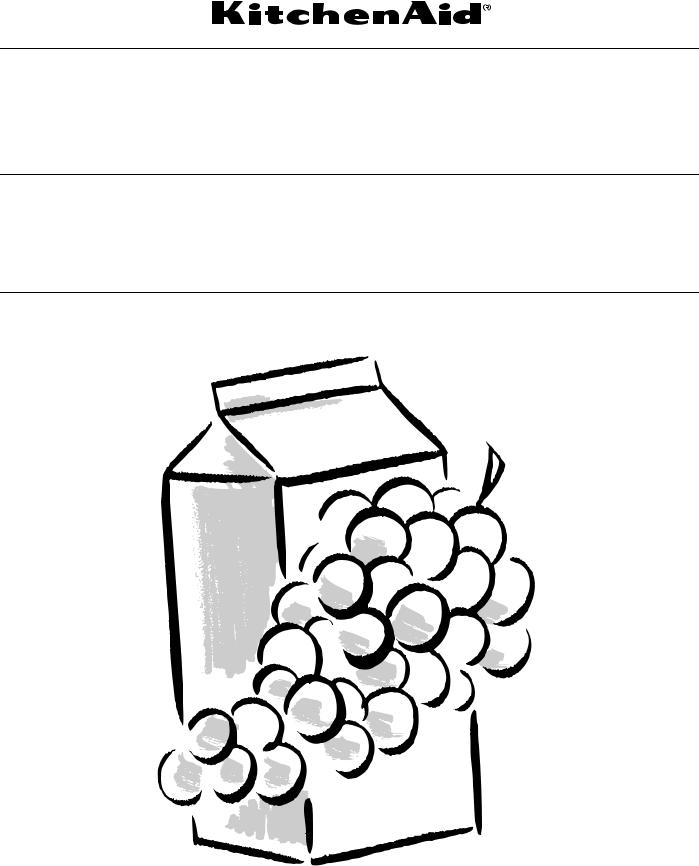
REFRIGERATOR
Use&CareGuide
For questions about features, operation/performance, parts, accessories or service, call: 1-800-422-1230
In Canada, call for assistance 1-800-461-5681, for installation and service, call: 1-800-807-6777 or visit our website at...
www.kitchenaid.com or www.KitchenAid.ca
RÉFRIGÉRATEUR |
|
Guided’utilisationetd’entretien |
|
Au Canada, pour assistance composez le 1-800-461-5681, pour installation ou service composez le 1-800-807-6777 ou visitez notre site web à... |
|
www.KitchenAid.ca |
|
Table of Contents/Table des matières............................................................................. |
2 |
2300260

TABLE OF CONTENTS |
|
REFRIGERATOR SAFETY ............................................................. |
3 |
Proper Disposal of Your Old Refrigerator.................................... |
3 |
INSTALLATION INSTRUCTIONS .................................................. |
4 |
Tools and Parts ............................................................................ |
4 |
Location Requirements................................................................ |
4 |
Electrical Requirements ............................................................... |
4 |
Unpack the Refrigerator............................................................... |
5 |
Reverse Door Swing (optional) .................................................... |
5 |
Door Closing................................................................................. |
6 |
Base Grille .................................................................................... |
7 |
REFRIGERATOR USE .................................................................... |
7 |
Normal Sounds ............................................................................ |
7 |
Using the Control ......................................................................... |
7 |
REFRIGERATOR FEATURES ........................................................ |
8 |
Split-level shelf ............................................................................. |
8 |
Lower Shelf................................................................................... |
8 |
Wire Storage Bin .......................................................................... |
8 |
DOOR FEATURES .......................................................................... |
8 |
Can Rack...................................................................................... |
8 |
Door Bin........................................................................................ |
8 |
REFRIGERATOR CARE ................................................................. |
9 |
Cleaning........................................................................................ |
9 |
Changing the Light Bulb .............................................................. |
9 |
Vacation and Moving Care........................................................... |
9 |
TROUBLESHOOTING .................................................................. |
10 |
ASSISTANCE OR SERVICE......................................................... |
11 |
In the U.S.A. ............................................................................... |
11 |
In Canada ................................................................................... |
11 |
Accessories ................................................................................ |
11 |
WARRANTY .................................................................................. |
12 |
TABLE DES MATIÈRES |
|
SÉCURITÉ DU RÉFRIGÉRATEUR .............................................. |
14 |
Mise au rebut de votre vieux réfrigérateur................................. |
14 |
INSTRUCTIONS D’INSTALLATION............................................. |
15 |
Outillage et pièces nécessaires ................................................. |
15 |
Emplacement d’installation........................................................ |
15 |
Spécifications électriques .......................................................... |
15 |
Déballage du réfrigérateur.......................................................... |
16 |
Inversion du sens d'ouverture de la porte (option) .................... |
16 |
Fermeture de la porte................................................................. |
17 |
Grille de la base.......................................................................... |
18 |
UTILISATION DU RÉFRIGÉRATEUR.......................................... |
18 |
Sons normaux ............................................................................ |
18 |
Utilisation de la commande........................................................ |
18 |
CARACTÉRISTIQUES DU RÉFRIGÉRATEUR ........................... |
19 |
Tablette à deux niveaux ............................................................. |
19 |
Tablette inférieure....................................................................... |
19 |
Compartiment de rangement métallique ................................... |
19 |
CARACTÉRISTIQUES DE LA PORTE......................................... |
19 |
Porte-cannettes.......................................................................... |
19 |
Balconnet de porte..................................................................... |
19 |
ENTRETIEN DU RÉFRIGÉRATEUR ............................................ |
20 |
Nettoyage ................................................................................... |
20 |
Changement de l'ampoule d'éclairage...................................... |
20 |
Précautions à prendre pour les vacances et avant un |
|
déménagement .......................................................................... |
20 |
DÉPANNAGE................................................................................. |
21 |
ASSISTANCE OU SERVICE......................................................... |
22 |
Aux États-Unis............................................................................ |
22 |
Au Canada.................................................................................. |
22 |
Accessoires ................................................................................ |
22 |
GARANTIE..................................................................................... |
23 |
2
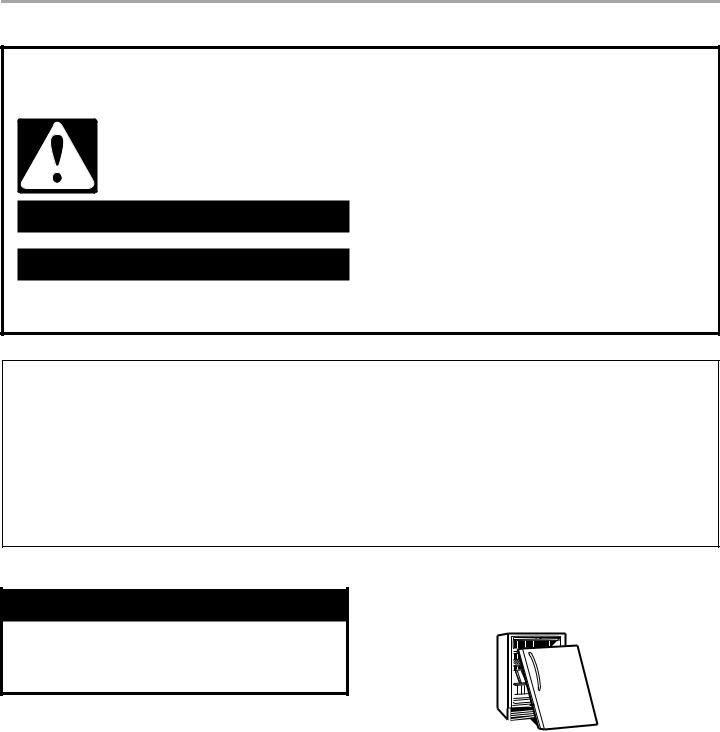
REFRIGERATORSAFETY
Your safety and the safety of others are very important.
We have provided many important safety messages in this manual and on your appliance. Always read and obey all safety messages.
This is the safety alert symbol.
This symbol alerts you to potential hazards that can kill or hurt you and others.
All safety messages will follow the safety alert symbol and either the word “DANGER” or “WARNING.” These words mean:
 DANGER
DANGER
 WARNING
WARNING
You can be killed or seriously injured if you don't immediately follow instructions.
You can be killed or seriously injured if you don't follow instructions.
All safety messages will tell you what the potential hazard is, tell you how to reduce the chance of injury, and tell you what can happen if the instructions are not followed.
IMPORTANT SAFETY INSTRUCTIONS
WARNING: To reduce the risk of fire, electric shock, or injury when using your refrigerator, follow these basic precautions:
■Plug into a grounded 3 prong outlet.
■Do not remove ground prong.
■Do not use an adapter.
■Do not use an extension cord.
■Disconnect power before servicing.
■Replace all parts and panels before operating.
■Remove doors from your old refrigerator.
■Use nonflammable cleaner.
■Keep flammable materials and vapors, such as gasoline, away from refrigerator.
■Use two or more people to move and install refrigerator.
SAVE THESE INSTRUCTIONS
Proper Disposal of Your Old Refrigerator
 WARNING
WARNING
Suffocation Hazard
Remove doors from your old refrigerator.
Failure to do so can result in death or brain damage.
IMPORTANT: Child entrapment and suffocation are not problems of the past. Junked or abandoned refrigerators are still dangerous
– even if they will sit for “just a few days.” If you are getting rid of your old refrigerator, please follow these instructions to help prevent accidents.
Before you throw away your old refrigerator or freezer:
■Take off the doors.
■Leave the shelves in place so that children may not easily climb inside.
3
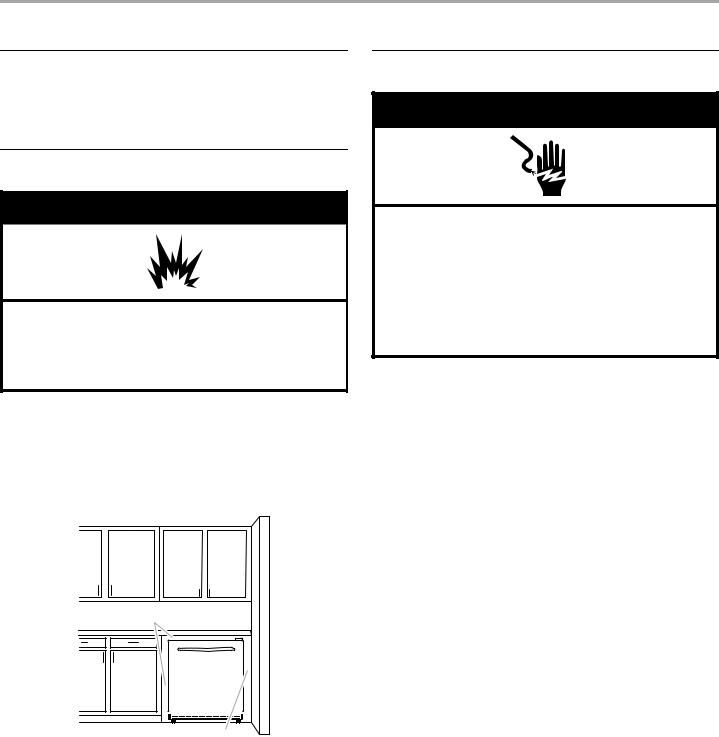
INSTALLATION INSTRUCTIONS
ToolsandParts
TOOLS NEEDED:
Gather the required tools and parts before starting installation.
■ ⁄" Allen wrench |
■ Phillips screwdriver |
LocationRequirements
 WARNING
WARNING
Explosion Hazard
Keep flammable materials and vapors, such as gasoline, away from refrigerator.
Failure to do so can result in death, explosion, or fire.
To ensure proper ventilation for your refrigerator, allow for a ¹/ " (0.64 cm) space on each side and at the top. When installing your refrigerator next to a fixed wall, leave 2¹⁄" (6.35 cm) minimum clearance on each side to allow for the door to swing open.
NOTE: Do not install the refrigerator near an oven, radiator, or other heat source, nor in a location where the temperature will fall below 55°F (13°C). For best performance, do not install the refrigerator behind a cabinet door or block the base grille.
Electrical Requirements
 WARNING
WARNING
Electrical Shock Hazard
Plug into a grounded 3 prong outlet.
Do not remove ground prong.
Do not use an adapter.
Do not use an extension cord.
Failure to follow these instructions can result in death, fire, or electrical shock.
Before you move your refrigerator into its final location, it is important to make sure you have the proper electrical connection.
Recommended grounding method
A 115 Volt, 60 Hz., AC only 15 or 20 amp fused, grounded electrical supply is required. It is recommended that a separate circuit serving only your refrigerator be provided. Use an outlet that cannot be turned off by a switch. Do not use an
extension cord.
NOTE: Before performing any type of installation, cleaning, or removing a light bulb, unplug refrigerator or disconnect power.
¹⁄ " (0.64 cm)
2¹⁄ " (6.35 cm)
4
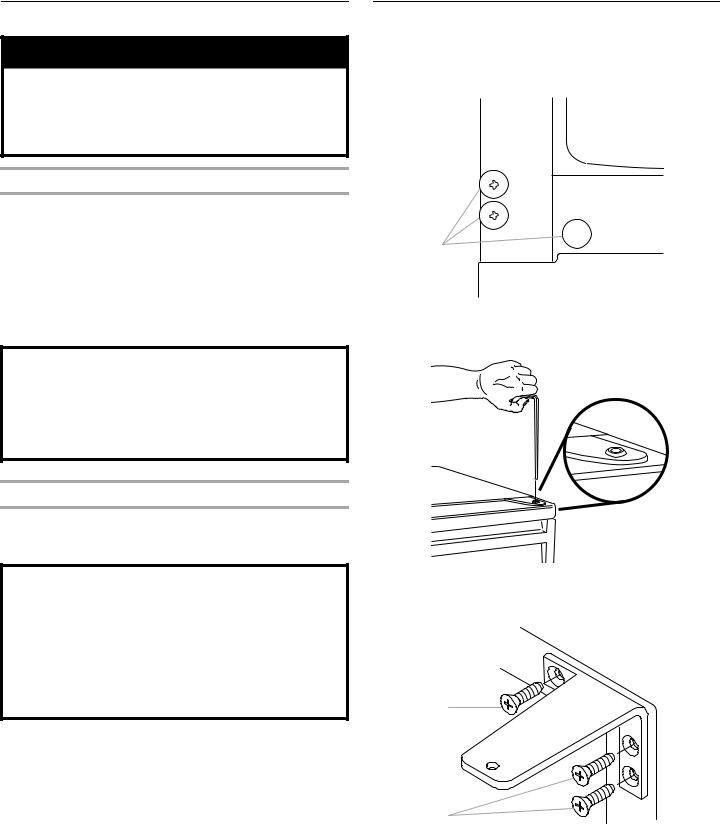
Unpack the Refrigerator
 WARNING
WARNING
Excessive Weight Hazard
Use two or more people to move and install refrigerator.
Failure to do so can result in back or other injury.
Remove the Packaging
■Remove tape and glue residue from surfaces before turning on the refrigerator. Rub a small amount of liquid dish soap over the adhesive with your fingers. Wipe with warm water and dry.
■Do not use sharp instruments, rubbing alcohol, flammable fluids, or abrasive cleaners to remove tape or glue. These products can damage the surface of your refrigerator. For more information, see “Refrigerator Safety.”
■Properly dispose of packaging.
When Moving Your Refrigerator:
Your refrigerator is heavy. When moving the refrigerator for cleaning or service, be sure to protect the floor. Always pull the refrigerator straight out when moving it.
Do not wiggle or “walk” the refrigerator when trying to move it, as floor damage could occur.
Clean Before Using
After you remove all of the packaging materials, clean the inside of your refrigerator before using it. See the cleaning instructions in “Refrigerator Care.”
Important information to know about glass shelves and covers:
Do not clean glass shelves or covers with warm water when they are cold. Shelves and covers may break if exposed to sudden temperature changes or impact, such as bumping. For your protection, tempered glass is designed to shatter into many small, pebble-size pieces. This is normal. Glass shelves and covers are heavy. Use special care when removing them to avoid impact from dropping.
Reverse Door Swing (optional)
1.Unplug refrigerator or disconnect power.
2.Remove three screw plugs (at top and bottom of refrigerator) from the new hinge locations on the refrigerator cabinet. Do not discard the screw plugs.
A 
A.Screw plugs
3.With a ⁄" Allen wrench, remove the top hinge pin and set aside.
4.Tilt the door forward and lift it off the bottom hinge pin. Set the door aside.
5.Remove the three hinge screws from the top hinge and remove the hinge.
A
B 

A
A.Hinge screws
B.Hinge pin hole
6.Reinsert the hinge pin into the hinge pin hole and turn the hinge upside down so that the hinge pin points up.
7.Install the hinge on the bottom opposite side of the refrigerator using the three hinge screws.
5
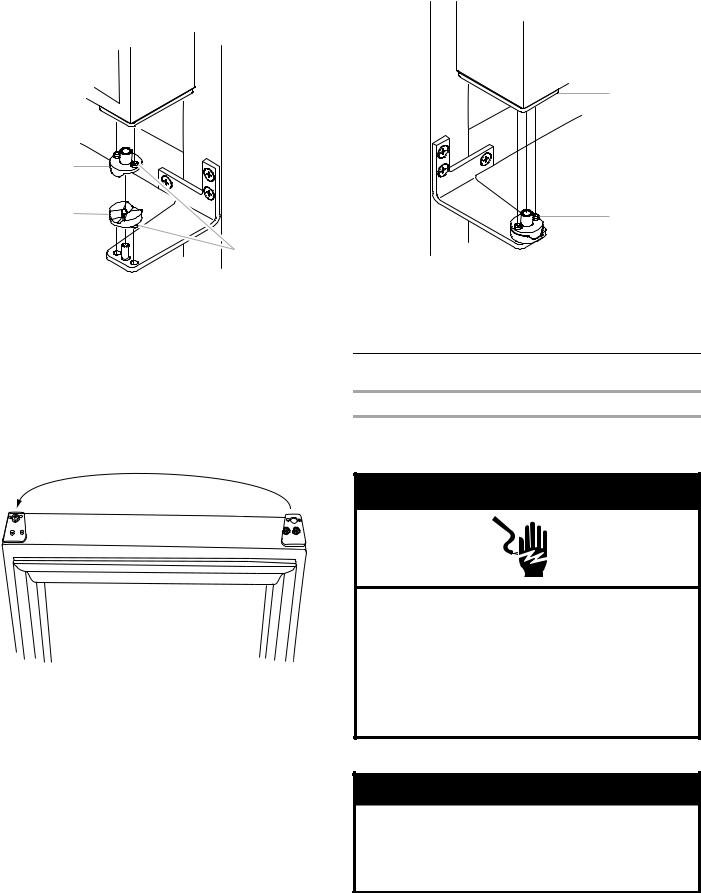
8.Remove the door closers from the old bottom hinge and install them on the new bottom hinge
IMPORTANT: Be sure to properly align the door closer– bottom bosses with the holes in the bottom hinge.
A
B
C
A.Door closer (top)
B.Door closer (bottom)
C.Bosses
9.Remove the three screws from the old bottom hinge and remove the hinge.
10.Turn the old bottom hinge upside down and reinstall on the top, opposite side of the refrigerator. Remove the hinge pin.
11.Turn the door upside down so the bottom of the door is facing up. Remove the two screws from the pivot plate and remove the plate.
12.Flip the plate over and reinstall it on the opposite side of the door.
13.Turn the door over so that the top of the door faces up.
14.Tilt the door forward and place the hole of the pivot plate on the new bottom hinge pin.
IMPORTANT: Be sure to properly align the door closer–top bosses with the holes in the hinge plate.
A
B
A.Pivot plate
B.Boss
15.Align the door with the top hinge and install the hinge pin.
16.Install the six plastic screw plugs in the old hinge holes on the top and the bottom of the cabinet.
Door Closing
Door Closing
Your refrigerator has four leveling legs. If your refrigerator seems unsteady or you want the door to close more easily, adjust the refrigerator’s tilt using the instructions below:
 WARNING
WARNING
Electrical Shock Hazard
Plug into a grounded 3 prong outlet.
Do not remove ground prong.
Do not use an adapter.
Do not use an extension cord.
Failure to follow these instructions can result in death, fire, or electrical shock.
1. Plug into a grounded 3 prong outlet.
 WARNING
WARNING
Excessive Weight Hazard
Use two or more people to move and install refrigerator.
Failure to do so can result in back or other injury.
2. Move the refrigerator into its final location.
6

3.Turn the leveling legs to the right to lower the refrigerator or turn the leveling legs to the left to raise it. It may take several turns of the leveling legs to adjust the tilt of the refrigerator.
NOTE: Having someone push against the top of the refrigerator takes some weight off the leveling legs. This makes it easier to adjust the leveling legs.
4.Open the door and check to make sure that it closes as easily as you like. If not, tilt the refrigerator slightly more to the rear by turning both front leveling screws to the right. It may take several more turns, and you should turn both leveling legs the same amount.
Base Grille
Remove the Base Grille:
1.Open the refrigerator door.
2.Using a Phillips screwdriver, remove the screws attaching the base grille to the refrigerator cabinet.
3.Pull the base grille toward you.
A
A
A 


A. Screws
Replace the Base Grille:
1.Open the refrigerator door.
2.Position the base grille so that the holes are aligned with the refrigerator and replace the screws.
REFRIGERATOR USE
Normal Sounds
Your new refrigerator may make sounds that your old one didn’t make. Because the sounds are new to you, you might be concerned about them. Most of the new sounds are normal. Hard surfaces, such as the flooring and surrounding structures, can make the sounds seem louder. The following describes the kinds of sounds and what may be making them.
■Your refrigerator is designed to run more efficiently to keep your food items at the desired temperatures and to minimize energy usage. The high efficiency compressor and fans may cause your refrigerator to run longer than your old one. You may also hear a pulsating or high-pitched sound from the compressor or fans adjusting to optimize performance.
■Rattling noises may come from the flow of refrigerant or items stored inside the refrigerator.
■As each cycle ends, you may hear a gurgling sound due to the refrigerant flowing in your refrigerator.
■You may hear water running into the drain pan when the refrigerator is defrosting.
■You may hear clicking sounds when the refrigerator starts or stops running.
Using the Control
For your convenience, your refrigerator control is preset at the factory. When you first install your refrigerator, make sure that the control is still preset to the mid-setting as shown.
Adjusting Controls
The mid-setting indicated in the previous section should be correct for normal usage. The control is set correctly when beverages are as cold as you like.
If you need to adjust the temperature, wait at least 24 hours between adjustments and then recheck the temperature.
To make the refrigerator colder, adjust the control to the next higher setting. To make the refrigerator less cold, adjust the control to the next lower setting.
7
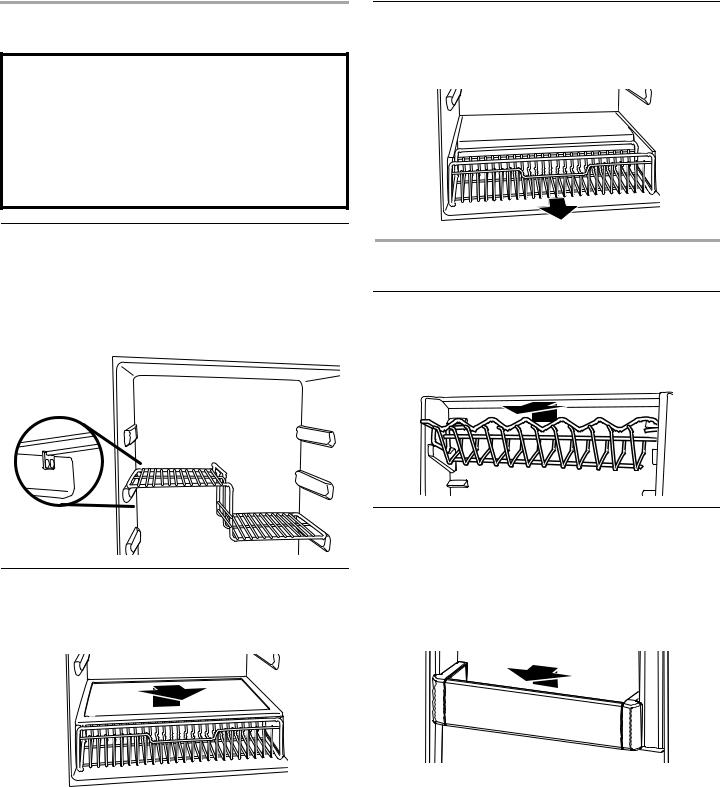
REFRIGERATOR FEATURES
Important information to know about glass shelves and covers:
Do not clean glass shelves or covers with warm water when they are cold. Shelves and covers may break if exposed to sudden temperature changes or impact, such as bumping. For your protection, tempered glass is designed to shatter into many small, pebble-size pieces. This is normal. Glass shelves and covers are heavy. Use special care when removing them to avoid impact from dropping.
Wire Storage Bin
To Remove and Replace Wire Storage Bin:
1.Remove the bin by pulling it forward.
2.Replace the bin by sliding it back into place.
Split-level shelf
Your refrigerator has an adjustable split-level shelf for maximum storage capability.
To Remove and Replace Shelf:
1.Remove the shelf by lifting it up out of the shelf clip.
2.Replace the shelf by aligning it over the clips and pressing it into place.
Lower Shelf
To Remove and Replace Lower Shelf:
1.Remove the shelf by lifting it up and pulling it forward.
2.Replace the shelf by lowering it on the guides.
DOOR FEATURES
Can Rack
To Remove and Replace Can Rack
1.Remove the can rack by tilting it forward and pulling it out.
2.Replace the rack by placing the rear of the rack under the support on the door and sliding into place.
Door Bin
The door bin can be positioned either on the upper door or the lower door.
To Reposition the Door Bin:
1.Remove the door bin by tilting it forward and pulling it out.
2.Replace the bin by placing the rear of the bin under the support on the door and sliding into place.
8
